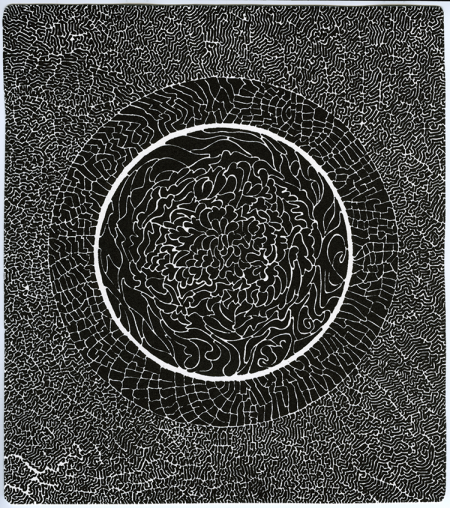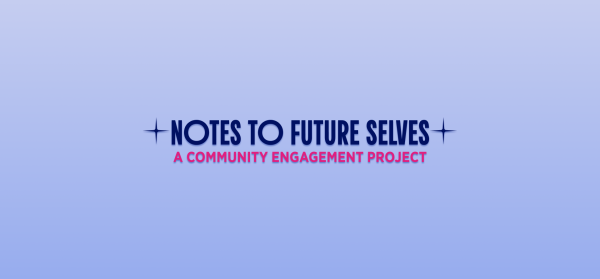Current Exhibitions

Inner Vision: Abstraction and Cognition
Main Gallery, February 13 – May 8, 2025
Inner Vision: Abstraction and Cognition considers the use of abstraction to investigate the nature of thought, experience, and the senses. Exploring abstraction as a language that spans lived experience, scientific inquiry, and diverse epistemological frameworks, Inner Vision examines a range of abstract representations of cognition and sensation including emotional states, dreams, hallucinations, mystical experience, and neurological phenomena. While their visual dialects vary, each artist investigates the complexities of inner perception and sensation. Some works offer critical perspectives on cultural signifiers to convey belief systems. Others examine altered states of consciousness through abstracted scientific models. Still others investigate the ways color and form activate personal and collective memory. Many of the works explore and engage perceptual awareness. Together, they demonstrate the potential of abstraction to understand and communicate the full spectrum of lived experience.
Featured artists: Bhakti Baxter, Terri Friedman, Rema Ghuloum, Dennis Koch, Robin Mitchell, Bridget Mullen, Angeline Rivas, Adee Roberson, Barbara Rossi, and Vian Sora

Main Gallery Corridor, February 13 – May 8, 2025
With this group of lithograph prints, artist Bruce Conner (1933-2008) reproduced a series of highly detailed but fading images he originally created using felt-tip pens. The nine prints on display explore the act of perception by prompting prolonged, up-close viewing. The meticulous black and white compositions recall mandala forms as well as microscopic imagery. The selected prints on view are part of the Museum’s permanent collection.

Mini Gallery, February 13 – May 8, 2025
Jodie Mack’s handmade collage films blend techniques of abstraction and optical science to create richly layered perceptual tapestries. Glistening Thrills is an approximately 9-minute audiovisual film set to play on a loop for the duration of the exhibition. The gallery setting facilitates an immersive experience that builds upon the themes of the Main Gallery exhibition, Inner Vision: Abstraction and Cognition.
Community Gallery, February 13 – May 8, 2025
Brittany Mojo: A Vocabulary of Objects offers an intimate glimpse into the artist’s studio practice. The exhibition features dozens of hand-molded ceramic pieces—among them dog bones, kitchen spoons, birds, bottles, eggs, and throwing dice—which the artist sculpts while conceptualizing and building a larger piece. Mojo describes the small objects as “little memory palaces” that accumulate in her studio, taking on new meanings and associations over time. Rooted in personal memory and nostalgia, Mojo’s diaristic vocabulary of objects speaks to the idiomatic relationships we form with our surroundings. A large stoneware piece, Plumb Bob (2025), anchors the installation.
Brittany Mojo received a BFA in Ceramics from Cal State Long Beach in 2013.

Laurie Steelink: A Love Supreme
Glenn Court, February 13 – May 8, 2025
Saturated with vivid colors and teeming with clusters of organic, cell-like forms, Laurie Steelink’s A Love Supreme (2010) seems to pulsate with life and energy. A meditation on interpersonal connection and reciprocal support systems, the artist created the work during a period of deep contemplation on the nature of life and love. Steelink’s abstract imagery references scientific and spiritual perspectives, from cellular structures seen under a microscope to altered visions that can arise when using plant medicines.

Carolyn Campagna Kleefeld Gallery, Ongoing
Notes to Future Selves: A Community Engagement Project is a participatory exhibition that invites the community to create artwork in response to the prompt: What do you want the future of your community to look like? Participants are given the option to display their artwork in the Carolyn Campagna Kleefeld Gallery for the duration of the exhibition.
Inspired by the Museum’s 50th anniversary in 2024 and this year’s 75th anniversary of California State University, Long Beach (CSULB), Notes to Future Selves embraces these milestones as a powerful moment for collective reflection. The exhibition celebrates the CSULB community’s diversity of voices, perspectives, experiences, and visions for the future.
Notes to Future Selves will be updated weekly as artwork submissions are received from the community.
Learn how to participate in the exhibition.
In conjunction with Notes to Future Selves, a section of the Carolyn Campagna Kleefeld Gallery features selections from the Museum’s permanent collection that engage introspective practices, such as recording everyday events, experiences, or observations in a sketchbook or journal or expressing one’s thoughts and feelings through personal iconography. Featured artists include Hannelore Baron, Carolyn Kleefeld, Joyce Treiman, and Beth Van Hoesen.

Walasse Ting: 1¢ Life
Prints and Drawings Room, February 13 – May 8, 2025
1¢ Life (1964) is a collaborative book project by Chinese-American visual artist and poet Walasse Ting (1929-2010). The book combines written works by Ting with artwork by various artists associated with Pop Art and Abstract Expressionism, including Sam Francis (who edited the book), Roy Lichtenstein, Joan Mitchell, Robert Rauschenberg, and Andy Warhol, among others. Ting’s witty wordplay and biting sense of humor is evident throughout the book, as is 1960s experimentation and iconoclasm. The book includes thirty-one folios, which will be on display with weekly rotations over the course of fall 2024 and spring 2025 semesters. 1¢ Life is part of the Museum’s permanent collection.
Reservations are available for visitor exhibition viewing sessions in the David Campagna Prints and Drawings Room. To make a reservation to view this exhibition, please fill out a request at least two weeks in advance.
Prints and Drawings Hallway, February 13 – May 8, 2025
Looking closely at three works from the Museum’s permanent collection, Word & Image explores the interplay of symbolic meanings and metaphors that emerge when visually combining text and image. How do text and image interactions guide our perceptions? How, for example, do word/image juxtapositions enhance or contradict meaning or introduce ambiguity? The exhibition includes prints by Wayne Campbell, Michael Goldberg, and Manuel Rodriguez.
Selections from the Permanent Collection
Archives Room, Ongoing
A selection of artwork from Kleefeld Contemporary's permanent collection is displayed in the Archives Room on an ongoing basis.
The Archives Room is available to reserve for research requests. To make a reservation, please fill out a request at least two weeks in advance.
Upcoming Exhibitions
INSIGHTS 2025
Select museum galleries, May 21 – July 11, 2025
INSIGHTS is the annual juried School of Art (SOA) student exhibition at California State University, Long Beach. A selection of student artwork from INSIGHTS 2025 will be on display at Carolyn Campagna Kleefeld Contemporary Art Museum.




